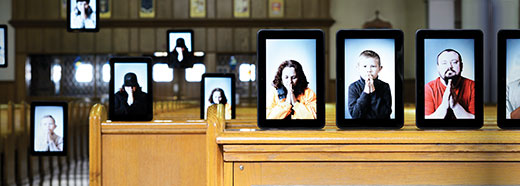Looking for new ways for their congregations to continue worshiping together during the pandemic, many pastors moved services online. In the process, they gave rise to the “digital church.”
For many churches, websites, Facebook Live, YouTube and Zoom calls became new “front doors” as church leaders rapidly adopted or depended more upon video technology to offer livestreaming or recorded services online. In January 2022, a Lifeway Research survey found that 94 percent of Protestant churches were offering video content for their congregations, including 84 percent who were livestreaming worship services.
Meanwhile, a Barna study in June 2020 found 2 in 5 practicing Christians and 1 in 10 non-practicing Christians had listened to or watched a message by a church leader in the past month. Among Protestant pastors, 40 percent said they have seen an increase in virtual attendance.
It’s safe to say more Christians were worshiping, praying and tithing online than ever before, as social distancing guidelines hampered in-person church gatherings. “Churches’ digital resources typically supplement in-person gatherings, providing access for those who are sick or traveling … . But now they are a lifeline, whether for worship, tithing, small groups, or prayer,” Kate Shellnutt observed in an article aptly titled “When God Closes a Church Door, He Opens a Browser Window,” posted by Christianity Today.
Lifeway Research study found that 45 percent of Americans had watched a service online, including 15 percent who normally didn’t attend church. “Livestreaming has done a lot of good for churches, allowing members to hear weekly messages during the pandemic and allowing churches to reach new people,” explained Scott McConnell, executive director of Lifeway Research.
Some pastors, however, have grown concerned about the digital church’s lasting effects as in-person attendance levels are slow to recover. While the vast majority of churches are meeting in person again, only 22 percent said attendance is greater than 90 percent of pre-pandemic levels, the survey showed. The average church reports an attendance of about three-quarters of what it was before COVID-19.
A Pew Research Center article cut to the chase: “Will the coronavirus permanently convert in-person worshippers to online streamers?”
“Whatever the reasons, lots of people like virtual worship,” observes Alan Cooperman, Pew’s director of religion research, noting more than 90 percent of those who had watched a recent online service said they were either very or somewhat satisfied.
“So what does this bode for the future?” he asks. “Some commentators have suggested that just as the pandemic has accelerated the trend toward shopping online and made Americans reliant on the internet for work, school, health and entertainment, so might many, if not all, varieties of religious experience move online in the 21st century,” he continues.
Not to worry, his forecast remains optimistic: Most people will go back to attending services in person, at least as often as they did before the pandemic. Ten percent even said they would go more often. Among regular church attenders, 92 percent anticipate returning to their pews, while just 2 percent will attend church less often.
Yet, there also are some positives to be gleaned from the digital revolution that swept the church. Although some members have not yet returned, 3 out of 4 pastors believe new people have been reached through their online services. More than 80 percent said some have even attended in person.
In addition, providing digital services and embracing Zoom video calls, text messaging and online chat features have helped church and Sunday school leaders stay more in touch with members. Some homebound or sick members have discovered a way to reconnect with their home churches, provided someone will assist them in bridging the technology gap when needed. The key for ministers was being able to create a supportive atmosphere of care and community online during the pandemic and connecting with those who need prayer.
Some inevitably will focus on the limitations of digital worship: the lack of interpersonal interaction and the emotional connection made with fellow members. While the biblical word ecclesia connotes the church as a gathered body of Christ — typically understood to mean a physical fellowship — others may envision a broader, more expansive gathering that utilizes emerging communication technologies and encompasses an ever-increasing digital society.
Rather than seeking a return to what has been, maybe the post-COVID church is better seen as an emerging hybrid gathering. Like a hybrid vehicle powered by both electric and gasoline motors, the digital church is a technologically enhanced ecclesia comprised of both those who continue to gather on campus and its extension of online worshipers — yet still one body worshiping together.
Indeed, an exciting new era for the church may be on hand: “The distance to one’s nearest church has changed almost overnight,” McConnell of Lifeway Research, remarked.
“A form of communication that was not even used by most churches before the pandemic has now reached almost half of Americans.”

